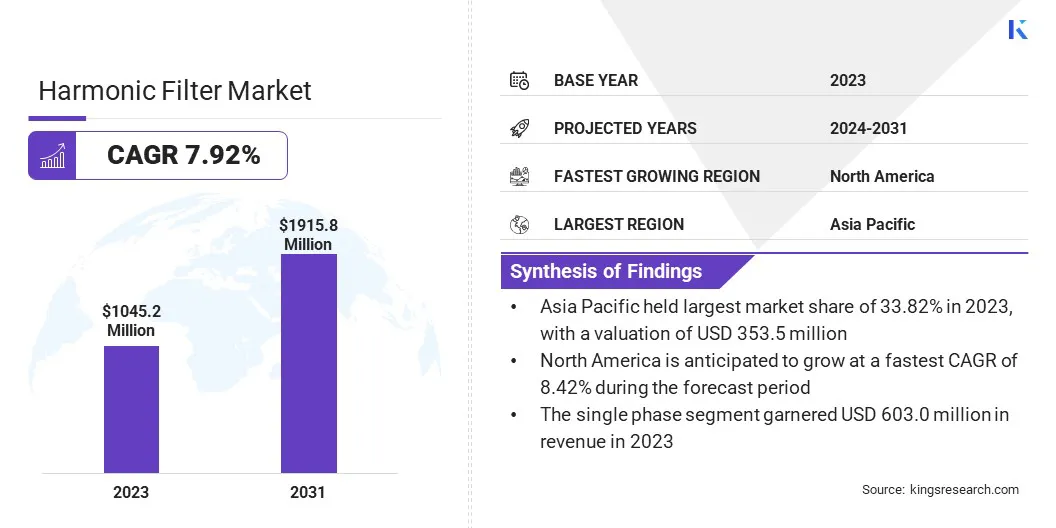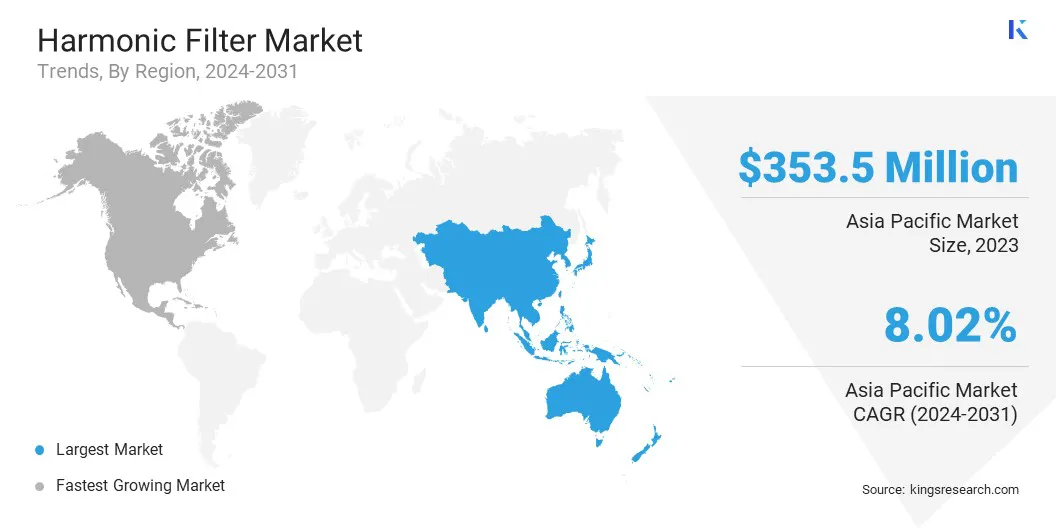Market Definition
The market involves the production of harmonic filters, which are electrical devices used to reduce or eliminate harmonic distortion in power systems caused by non-linear loads like variable frequency drives.
By filtering out unwanted harmonic frequencies, they improve power quality, protect equipment, and enhance energy efficiency. The report offers a thorough assessment of the main factors driving the market, along with detailed regional analysis and the competitive landscape influencing market dynamics.
Harmonic Filter Market Overview
The global harmonic filter market size was valued at USD 1045.2 million in 2023, which is estimated to be USD 1123.7 million in 2024 and reach USD 1915.8 million by 2031, growing at a CAGR of 7.92% from 2024 to 2031.
Rapid urbanization and large-scale infrastructure projects lead to more complex electrical systems. The demand for harmonic filters rises to maintain power quality, efficiency, and system stability as non-linear loads increase.
Major companies operating in the harmonic filter industry are ABB, Schneider Electric, Siemens AG, Danfoss A/S, Schaffner Holding AG, TDK Electronics AG, Eaton, Comsys AB, MTE Corporation, Baron Power, Trinity Energy Systems Pvt. Ltd., Enspec Power Ltd, ARTECHE, KYOCERA AVX, and Mirus International Inc.
The market is registering growth, driven by the increasing need for efficient power management and the expansion of industrial automation and renewable energy integration. Modern electrical systems are becoming more complex, boosting the demand for solutions that enhance power stability and reduce energy losses.
Technological advancements, regulatory mandates for power quality, and the need to protect sensitive equipment from voltage distortion are further accelerating the market adoption.

Key Highlights:
- The harmonic filter industry size was valued at USD 1045.2 million in 2023.
- The market is projected to grow at a CAGR of 7.92% from 2024 to 2031.
- Asia Pacific held a market share of 33.82% in 2023, with a valuation of USD 353.5 million.
- The active segment garnered USD 7 million in revenue in 2023.
- The single phase segment is expected to reach USD 1090.7 million by 2031.
- The low segment held a market share of 38.45% in 2023.
- The residential segment is anticipated to grow at a CAGR of 8.06% during the forecast period.
- The market in North America is anticipated to grow at a CAGR of 8.42% during the forecast period.
Market Driver
"Urbanization and Infrastructure Development"
Rapid urbanization and large-scale infrastructure projects are driving the harmonic filter market. The complexity of electrical systems increases as cities expand and new buildings, factories, and commercial spaces develop.
These systems often involve non-linear loads, which are electrical devices or systems that draw current in a non-linear manner, causing distortion in the power waveform and affecting power quality & efficiency.
Harmonic filters are essential in managing these distortions, ensuring stable & efficient operation of electrical equipment, and preventing damage. This growing demand for infrastructure and urban development fuels the market for harmonic filters.
- In March 2024, researchers from Guangzhou Maritime College, Shanghai Maritime University, and South China University of Technology proposed a novel method for tuning the parameters of parallel-connected capacitors in HVDC systems. This approach accounts for the impact of varying power system strengths on harmonic filtering performance, ensuring that the capacitance range meets filtering requirements under different system conditions. Their research aims to enhance the stability and efficiency of LCC-HVDC systems by optimizing filtering techniques, addressing challenges in reactive power compensation, and improving overall system operation.
Market Challenge
"Dependence on Skilled Labor"
Dependence on skilled labor is a significant challenge in the harmonic filter market, as the design, installation, and maintenance of these systems require technical expertise and specialized knowledge. This creates barriers in regions with limited access to trained professionals, slowing adoption and increasing operational risks.
A viable solution is investing in workforce development through industry-specific training programs and partnerships with technical institutions. Additionally, manufacturers can simplify system design and provide user-friendly installation guides to reduce dependency on highly specialized labor, facilitating broader market penetration.
Market Trend
"Customization and Modular Solutions"
Customization and modular solutions are emerging as significant trends in the harmonic filter market, driven by the diverse and evolving needs of industries such as manufacturing, automotive, and renewable energy. Manufacturers are now offering harmonic filters that can be tailored to specific voltage levels, load types, and space constraints.
Modular designs allow for easier installation, scalability, and maintenance, enabling end users to adapt their filtering solutions as system demands change. This flexibility enhances performance, reduces downtime, and supports long-term cost efficiency across various applications.
- In October 2023, MTE Corporation expanded its SineWave Nexus Filters to support up to 350 HP for 480-volt applications. These advanced filters enhance motor protection by mitigating harmful harmonics from variable frequency drives, significantly improving power quality, system efficiency, and equipment longevity.
Harmonic Filter Market Report Snapshot
|
Segmentation
|
Details
|
|
By Type
|
Active, Passive, Hybrid
|
|
By Phase
|
Single Phase, Three Phase
|
|
By Voltage
|
Low, Medium, High
|
|
By End Use
|
Residential, Commercial, Industrial
|
|
By Region
|
North America: U.S., Canada, Mexico
|
|
Europe: France, UK, Spain, Germany, Italy, Russia, Rest of Europe
|
|
Asia-Pacific: China, Japan, India, Australia, ASEAN, South Korea, Rest of Asia-Pacific
|
|
Middle East & Africa: Turkey, U.A.E., Saudi Arabia, South Africa, Rest of Middle East & Africa
|
|
South America: Brazil, Argentina, Rest of South America
|
Market Segmentation:
- By Type (Active, Passive, Hybrid): The active segment earned USD 440.7 million in 2023, due to the rising demand for dynamic filtering in systems with fluctuating loads and the growing adoption of smart power management technologies.
- By Phase (Single Phase, Three Phase): The single phase segment held 57.70% share of the market in 2023, due to its increased use in residential and small commercial setups requiring compact, cost-effective harmonic mitigation solutions.
- By Voltage (Low, Medium, High): The low segment is projected to reach USD 737.6 million by 2031, owing to growing installations in light-duty applications and expansion of renewable energy systems with low voltage requirements.
- By End Use (Residential, Commercial, Industrial): The residential segment is anticipated to register a CAGR of 8.06% during the forecast period, driven by increasing power quality concerns from electronics-heavy households and smart home infrastructure.
Harmonic Filter Market Regional Analysis
Based on region, the market has been classified into North America, Europe, Asia Pacific, Middle East & Africa, and South America.

Asia Pacific harmonic filter market share stood at around 33.82% in 2023, with a valuation of USD 353.5 million. Asia Pacific dominates the market, due to rapid industrialization, increasing energy demand, and the expansion of renewable energy projects.
Countries like China, Turkey, India, and Japan are major contributors, implementing stringent power quality regulations and adopting advanced technologies to manage harmonic distortions.
The growing adoption of Electric Vehicles (EVs), smart grids, and sustainable energy solutions further drives the demand for harmonic filters. Additionally, the region’s large-scale infrastructure development and high industrial activities make it a key market for harmonic filter solutions.
- In March 2024, Quality Power provided harmonic filters to the Kalyon 1000 MW solar project in Turkey, enhancing power quality and grid stability. This collaboration emphasizes the importance of harmonic filters in large-scale renewable energy projects, supporting optimized performance and advancing Turkey’s renewable energy goals.
The harmonic filter industry in North America is poised for significant growth at a robust CAGR of 8.42% over the forecast period. North America is the fastest-growing region for the market, due to increasing industrialization, expanding renewable energy projects, and stringent government regulations on power quality.
The rising demand for energy-efficient solutions and the need to mitigate harmonic distortion in electrical systems drive the market. Additionally, advancements in smart grid technologies and the growing adoption of EVs further fuel the demand for harmonic filters, positioning North America as a key player in the market’s expansion.
Regulatory Frameworks
- In the U.S., the IEEE 519-2014 provides guidelines for harmonic control in electric power systems, establishing voltage and current waveform distortion goals. It focuses on reducing interference at the point of common coupling, addressing steady-state limitations and offering guidance for systems.
- Globally, the IEC 61000-4-7:2002 provides guidelines for measuring harmonics and interharmonics in power supply systems. It applies to instrumentation measuring spectral components up to 9 kHz, distinguishing between harmonics and interharmonics and ensuring accurate assessment for Electromagnetic Compatibility (EMC) compliance in 50 Hz and 60 Hz systems.
- In India, the Bureau of Indian Standards (BIS) IS 15395:2003 (IEC 61642-1997) (Reaffirmed 2023) provides guidelines for managing harmonics in industrial AC networks, focusing on the application of filters and shunt capacitors to mitigate harmonic distortions.
Competitive Landscape
Companies in the harmonic filter industry are focusing on developing advanced solutions that enhance energy efficiency and power quality. They are investing in innovative technologies like silicon carbide (SiC) switches to reduce power losses and improve harmonic mitigation.
Additionally, firms are emphasizing compact, modular designs to offer scalability and flexibility for various industrial applications. These companies are also ensuring compliance with international standards, such as IEEE 519, to meet the growing demand for reliable and sustainable power solutions across multiple sectors.
- In February 2025, Danfoss launched the Advanced Active Filter 007, a high-efficiency solution for harmonic mitigation, power factor correction, and imbalance compensation. Featuring silicon carbide (SiC) technology, it reduces power losses by 60%, ensuring superior harmonic elimination and compliance with IEEE 519 standards. The compact, modular design allows for scalability and offers environmental benefits by minimizing heat emissions and space requirements.
List of Key Companies in Harmonic Filter Market:
- ABB
- Schneider Electric
- Siemens AG
- Danfoss A/S
- Schaffner Holding AG
- TDK Electronics AG
- Eaton
- Comsys AB
- MTE Corporation
- Baron Power
- Trinity Energy Systems Pvt. Ltd.
- Enspec Power Ltd
- ARTECHE
- KYOCERA AVX
- Mirus International Inc.
Recent Developments (Product Launch)
- In January 2023, Danfoss introduced the Advanced Active Filter AAF 007, offering 60% lower power losses compared to similar filters. This innovative solution provides harmonic mitigation, power factor correction, and imbalance compensation, all in one unit. It helps optimize energy consumption while complying with international standards like IEEE 519, ensuring improved efficiency and reduced costs.


